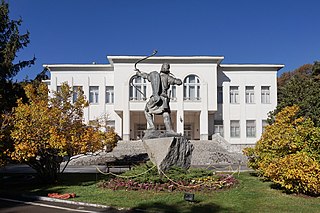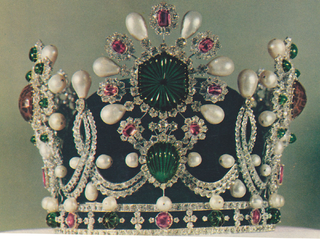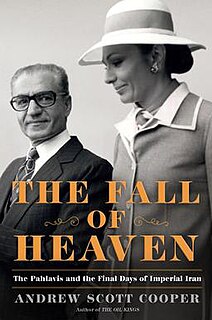
Soraya Esfandiary-Bakhtiary was the queen consort (Shahbanu) of Iran as the second wife of Shah Mohammad Reza Pahlavi, whom she married in 1951.

The Pahlavi dynasty was the last ruling house of the Imperial State of Iran from 1925 until 1979, when the Persian monarchy was overthrown and abolished as a result of the Iranian Revolution. The dynasty was founded by Reza Shah Pahlavi in 1925, a former brigadier-general of the Persian Cossack Brigade, whose reign lasted until 1941 when he was forced to abdicate by the Allies after the Anglo-Soviet invasion of Iran. He was succeeded by his son, Mohammad Reza Pahlavi, the last Shah of Iran.

Shahbanu was the title for queen consort in Persian and other Iranian languages. The two Persian Sassanian empresses regnant, Purandokht and Azarmidokht, c. 630, were the last two that carried the title before Farah Pahlavi, the wife of Mohammad Reza Pahlavi, the last Shah of Iran (Persia), assumed the title on being crowned queen in 1967 for the first time since the Arab conquest of Iran in the 7th century.

Reza Pahlavi is the last heir apparent to the defunct throne of the Imperial State of Iran and is the current head of the exiled House of Pahlavi. He is the older son of Mohammad Reza Pahlavi and his wife Farah Diba.

The Sa'dabad Palace Complex is a 300 hectare complex built by the Qajar and Pahlavi monarchs, located in Shemiran, Greater Tehran, Iran. Today, the official residence of the President of Iran is located adjacent to the complex.

The Iranian National Jewels, originally the Iranian Crown Jewels, include elaborate crowns, thirty tiaras, and numerous aigrettes, a dozen bejeweled swords and shields, a number of unset precious gems, numerous plates and other dining services cast in precious metals and encrusted with gems, and several other more unusual items collected or worn by the Persian monarchs from the 16th century on. The collection is housed at The Treasury of National Jewels, situated inside the Central Bank of Iran on Tehran's Ferdowsi Avenue.

Prince Alireza Pahlavi was a member of the Pahlavi Imperial Family of Iran (Persia). He was the younger son of Mohammad Reza Pahlavi, the former Shah of Iran and his third wife Farah Diba. He was second in order of succession to the Iranian throne before the Iranian Revolution.

Princess Farahnaz Pahlavi is the eldest daughter of Mohammad Reza Pahlavi by his third wife, Farah Diba.

Shahnaz Pahlavi is the first child of the Shah of Iran, Mohammad Reza Pahlavi, and his first wife, Princess Fawzia of Egypt.

Princess Ashraf ol-Molouk Pahlavi was the twin sister of Mohammad Reza Pahlavi, the last Shah of Iran (Persia), and a member of the Pahlavi dynasty. She was considered the "power behind her brother" and was instrumental in the 1953 coup which led to him taking the throne. She served her brother as a palace adviser and was a strong advocate for women's rights. Following the Iranian Revolution in 1979, she lived in exile in France, New York, Paris and Monte Carlo and remained outspoken against the Islamic Republic.
Imperial Majesty is a style used by Emperors and Empresses. It distinguishes the status of an emperor/empress from that of a King/Queen, who are simply styled Majesty. Holders of this style have sometimes been observed to follow religious leaders who are styled "His Holiness" in public ceremonies.

Reza Shah's Mausoleum, located in Ray south of Tehran, was the burial ground of His Imperial Majesty Reza Shah Pahlavi (1878-1944), the penultimate Shahanshah (Emperor) of Iran. It was built close to Shah-Abdol-Azim shrine.

The Empress Crown is part of the coronation regalia used by the only Shahbanu (Empress) of Iran, Farah Pahlavi. It is part of the Iranian Crown Jewels and is currently on display at the Central Bank of Iran in Tehran.

Mohammad Reza Pahlavi, also known as Mohammad Reza Shah, was the last King (Shah) of Iran from 16 September 1941 until his overthrow by the Iranian Revolution on 11 February 1979. Mohammad Reza Shah took the title Shahanshah on 26 October 1967. He was the second and last monarch of the House of Pahlavi. Mohammad Reza Shah Pahlavi held several other titles, including that of Aryamehr and Bozorg Arteshtaran ("Commander-in-Chief"). His dream of what he referred to as a "Great Civilisation" in Iran led to a rapid industrial and military modernisation, as well as economic and social reforms.

Leila Pahlavi was a princess of Iran and the youngest daughter of Mohammad Reza Pahlavi, Shah of Iran, and his third wife, Farah Pahlavi.

The Queen and I is a 2008 Swedish-made documentary feature film about Farah Pahlavi, the former Queen and Empress of Iran. The film was produced and directed by Iranian-Swedish filmmaker Nahid Persson Sarvestani. The film follows the former queen and empress and the director, a former communist, as they share ideas and concerns about the country they were both forced to leave after the revolution.

The Enigma of the Shah is an Iranian historical drama directed by Mohammad Reza Varzi. The story focuses on Mohammad Reza Pahlavi, the last Shah of Iran, and the events leading up to the 1979 Iranian revolution which led to the abolition of the monarchy.

The Fall of Heaven: The Pahlavis and the Final Days of Imperial Iran is a 2016 book by Andrew Scott Cooper. It documents the Pahlavi family and the overthrow of the Shah of Iran.



















